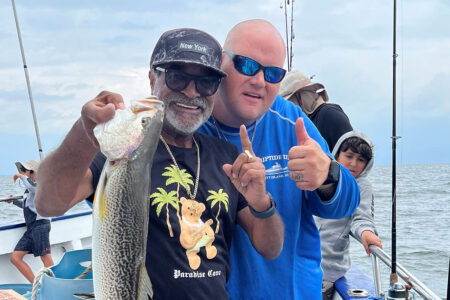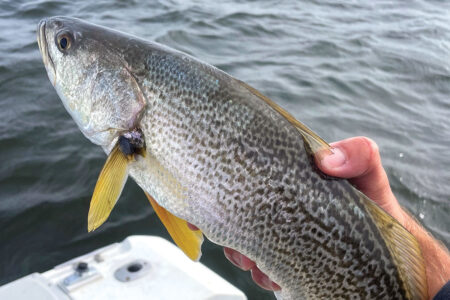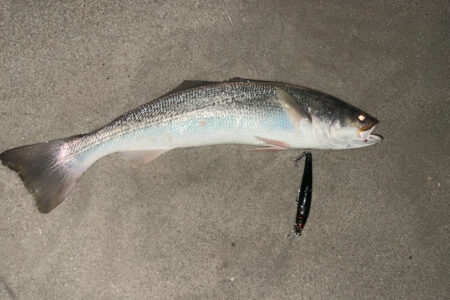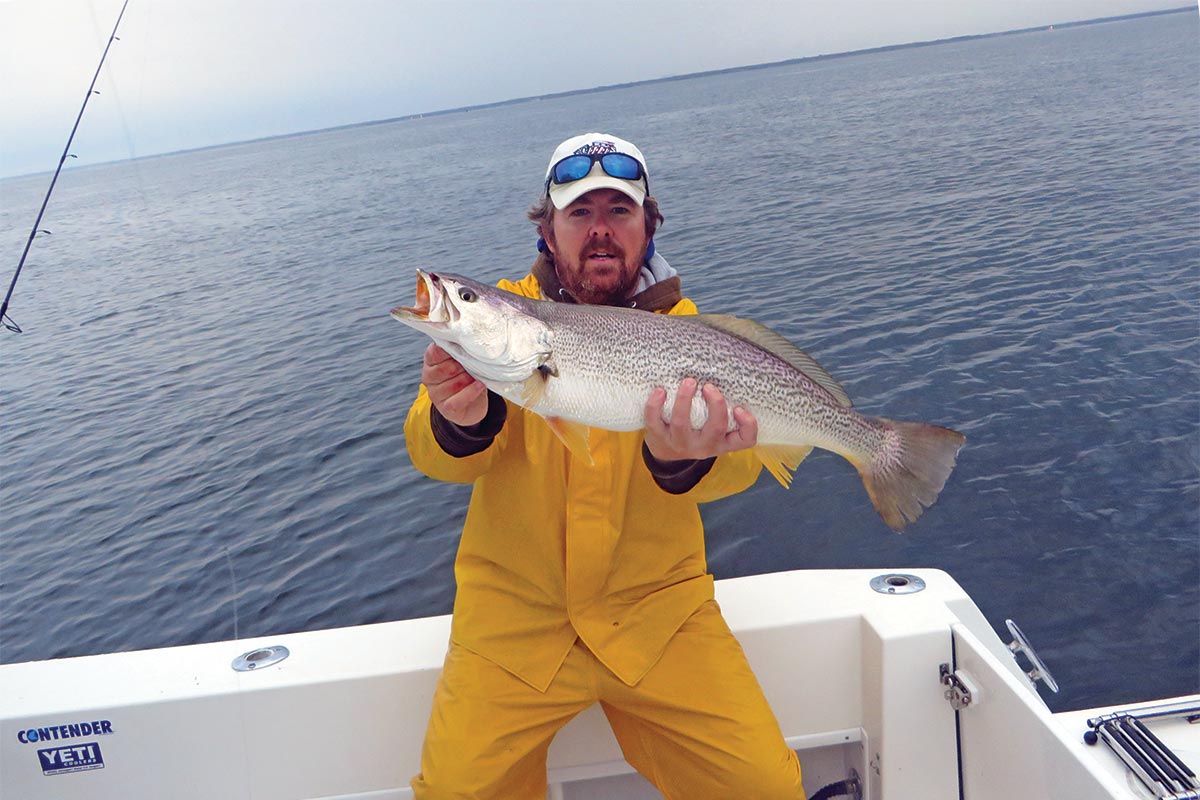
The unpredictable weakfish appear on the verge of a comeback, and that’s good news for Northeast inshore anglers.
I wasn’t around for the good old days of weakfishing back in the 1970s but I have heard many stories about the quantity and quality of weakfish that made up the fishery back then. I’ve also heard that weakfish are very cyclical. After the month of May and early part of June that I experienced in my home waters of Great South Bay on Long Island, and hearing reports from other parts of the Island, western Long Island Sound and New Jersey, I’m hopeful that we might have a few good years ahead of us. When the stocks are healthy, the good fishing can extend from South Jersey to well into New England so let’s keep our fingers crossed.
Calendar
In the springtime weakfish enter into bays to spawn and are often concentrated in just a few areas. One such area where I fish can have 50 to 60 boats so tight to each other that you can almost walk from boat to boat, and this despite a one fish bag limit. If you are in search of a double digit fish it will most likely come in the springtime. In the summer these fish spread out and they are usually smaller than those that appeared in April and May. During the summer you can catch a lot of fish on peanut bunker while using a hi-lo rig. I’m not a snob when it comes to using bait, but I believe you can catch just as many weakfish by using the correct artificial lure.
Come fall, weakfish begin leaving the bays and head out into the ocean where they become mostly a bycatch for those jigging stripers. I don’t target weakfish once they have left the bays since the fishing can be very unpredictable and at times is made up of very small fish. Quite often people out bass fishing will comment about the abundance of bait in 20 to 30 feet of water. What they may not realize is that “bait” is actually acres of small weakfish. If you don’t believe me drop a small jig down and check it out for yourself.
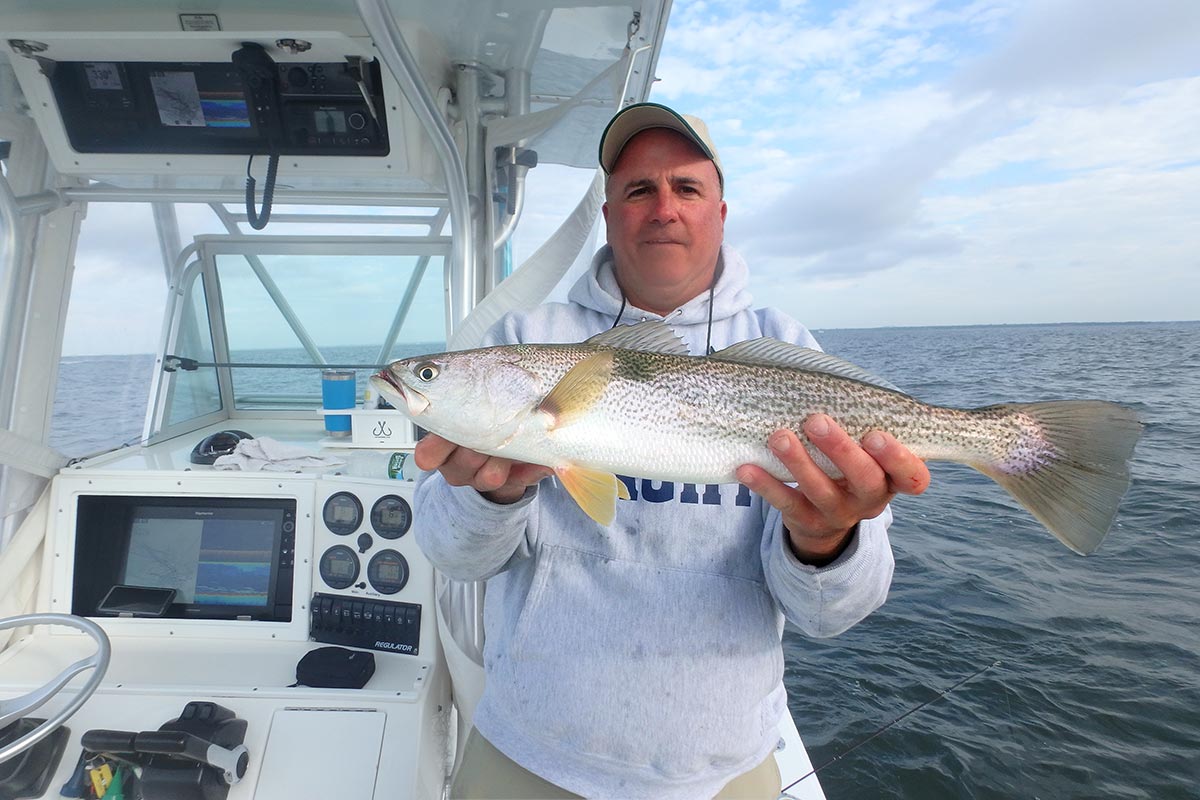
It’s All About Tide
It may shock you but you can catch a lot of fish smack in the middle of the day. As long as I can remember I was told that you needed to fish for weakfish at first light. I no longer believe that to be true. If first light coincides with the first hour of either the incoming or the outgoing tide then you might be in for a great bite. During May we had two separate days in which we boated over 50 weakfish just by making sure we caught the correct tide. Neither of those trips took place at first light. In fact they were smack in the middle of the day. If you miss the beginning of the tide change it doesn’t mean you can’t catch weakfish. It just means you will most likely experience a “pick” until the next tide change.
Light Tackle
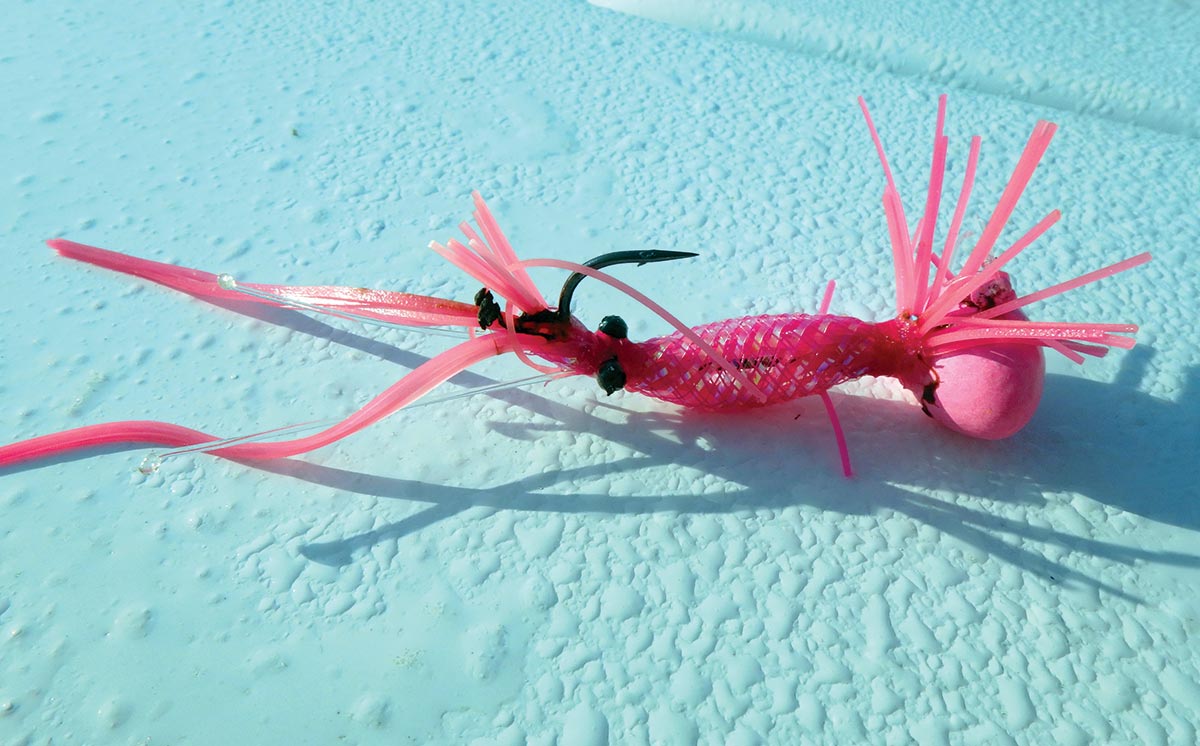
When it comes to weakfish the rod is very important. When I’m on the weakfish grounds I can pick out the boats that are going to have a tough time catching weakfish. Remember, weakfish are named after their “weak” mouths. If you show up with the wrong rod you are in for a day of frustration. I use a Shimano Teramar Southeast Spinning Rod. The model number is TMS-70M. The rod is rated medium power and the action is fast. In a pinch you can use the rod for shallow fluke fishing, casting to small blues and schoolie bass. However, the rod is best used as a one species type rod. Obviously that species is weakfish. Because the rod is very light in weight (just 5 ounces) it’s important to balance it out with a light but capable fishing reel. My reel of choice is a Daiwa BG 2500. The reel itself only weighs 9.3 ounces. That means the setup comes in at roughly 15 ounces. This set up will run you about $230. If you are looking to go with something a little cheaper I suggest you try to save money on the reel. There are other reels in that size range out there that are less expensive that will get the job done. I think the rod is the most important part of weakfishing, so don’t skimp on it, but whichever reel you decide on make sure it has a smooth drag and I lean on setting it on the loose side. If it’s too tight you will end up losing a lot of fish. You need to finesse these fish to the boat. It’s the complete opposite of catching gator blues on poppers.
At the terminal end, I use an Alberto knot when tying my braid to leader. Your main line should be braid and I use no more than 15-pound test. My fluorocarbon leader also tests out at 15 pounds. The rod mentioned above is rated for 3/8 to 1-ounce lures and going with a light leader will help keep your lure in the strike zone. These fish hover near the bottom so you will need to adjust the size of the jig head/lure based on the wind and tide. Most of the time a 1/2-ounce jig head will do the trick. If you target weakfish in stronger currents don’t be afraid to go with 10-pound test. I would rather use lighter line and leader than going with a heavy jig head.
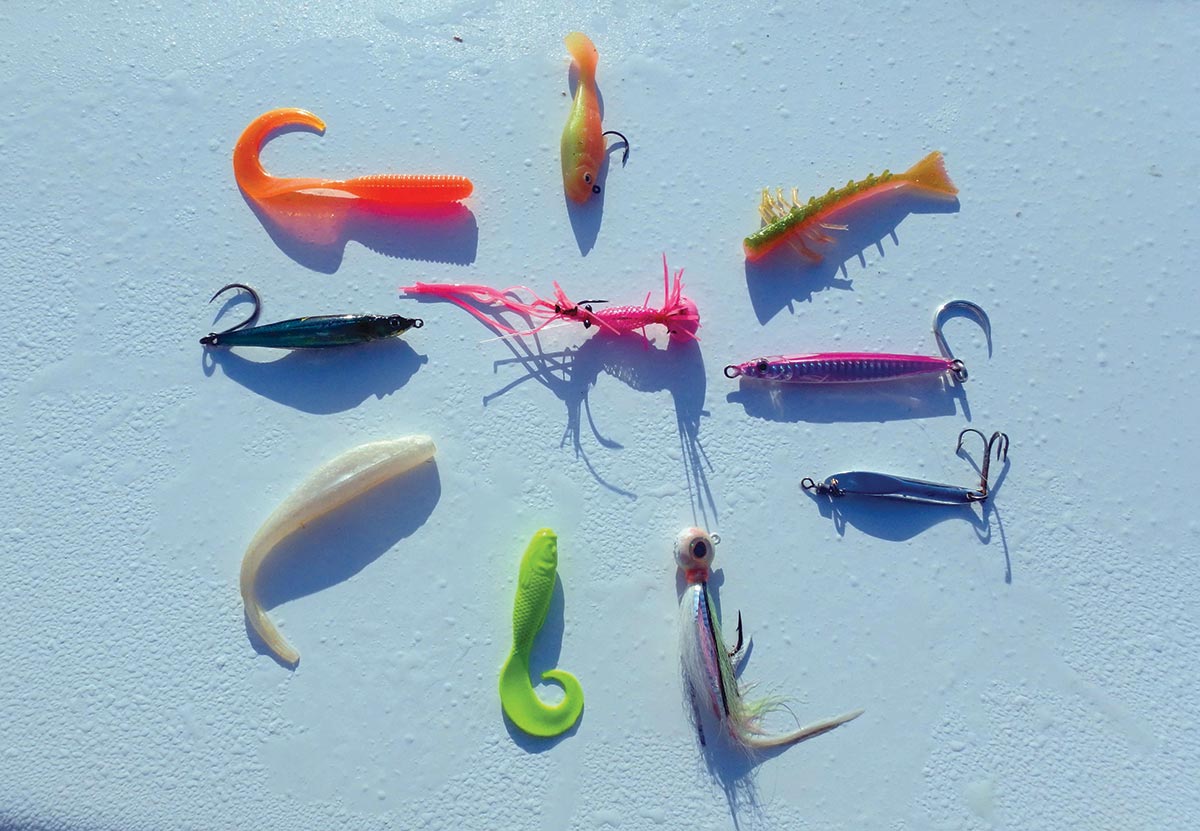
strike a wide selection of artificials
One of the great things about weakfish is that they will aggressively strike a wide range of lures so you have plenty of options. When the bite is on, weakfish will hit everything from Deadly Dicks to bucktails, to jig heads tipped with a soft plastic. Speaking of soft plastics, the choices are endless. I have caught weakfish on Gulp swimming mullet, Tsunami swim shads, Z-man scented shad, Hogy Originals, and the list goes on and on. However I find myself gravitating towards the same two as of late, the Gulp swimming mullet and Z-Man scented shad. Both of these soft plastics are used with a 1/2-ounce jig head. Everybody loves pink, however I really don’t care about color. The size and action of the soft plastic is what matters to me. These two soft plastics look great whether the tide is ripping or you are fishing slow moving water. Size really does matter. I keep all of my weakfish lures 4 inches and under. Even though you may come across a school of double digit fish, keep in mind they most likely are feeding on small baits. Most bays where weakfish are found have an abundance of spearing, bay anchovies and grass shrimp. It just happens that I was asked to try out a new weakfish shrimp jig. I can honestly tell you that this jig catches a lot of fish. It’s the perfect size and weight (1/2 ounce). I watched the guy who created this jig out fish every boat in the fleet using his shrimp jig. It is due to hit the market in 2020.
Positioning & Electronics
I’m blown away at the money people spend on outfitting their boat with today’s electronics. I should re-phrase that. It’s the lack of use that I’m blown away by despite spending thousands of dollars on electronics. Weakfish are concentrated in tight schools so it’s important to make sure you have the correct drift. Even on the water there are leaders and followers. Leaders are the ones that took the time to learn how to use their electronics. They realize how important they are when trying to find and stay with the fish. Followers will watch an angler catch a fish and then drive over to him and try to mimic that person’s drift, never even looking at his electronics. I run Raymarine Axiom Pros on my boat. I have a huge advantage over a boat that doesn’t have updated electronics. That may sound obnoxious but I am simply stating a fact. With my updated electronics I can clearly see the difference between bait and fish. This is where the advantage comes in. I can lineup my drifts over fish while those that don’t have upgraded electronics are wasting time drifting over bait thinking it’s fish. Quite often weakfish are not on the bait. You would be amazed at what a difference 10 yards makes. It’s the same premise as wreck fishing for blackfish. If you swing off the wreck you stop catching fish. When targeting weakfish it’s important to use a track line and waypoints. How else are you going to drift over the fish time and time again without using waypoints and a track line? If you watch the captains that are pulling up fish after fish you will see they are watching their electronics and adjusting the boat’s position to go over a track line or waypoint. Once you dial in to where the fish are, all you need to do is bump the motors in either forward or reverse for a second or two. A drift will change many times. The strength of the wind and the velocity of the current will change your drift many times within the same tide cycle. If you have spent the money on upgraded electronics, take the time to learn them so that you can take full advantage of their capabilities.
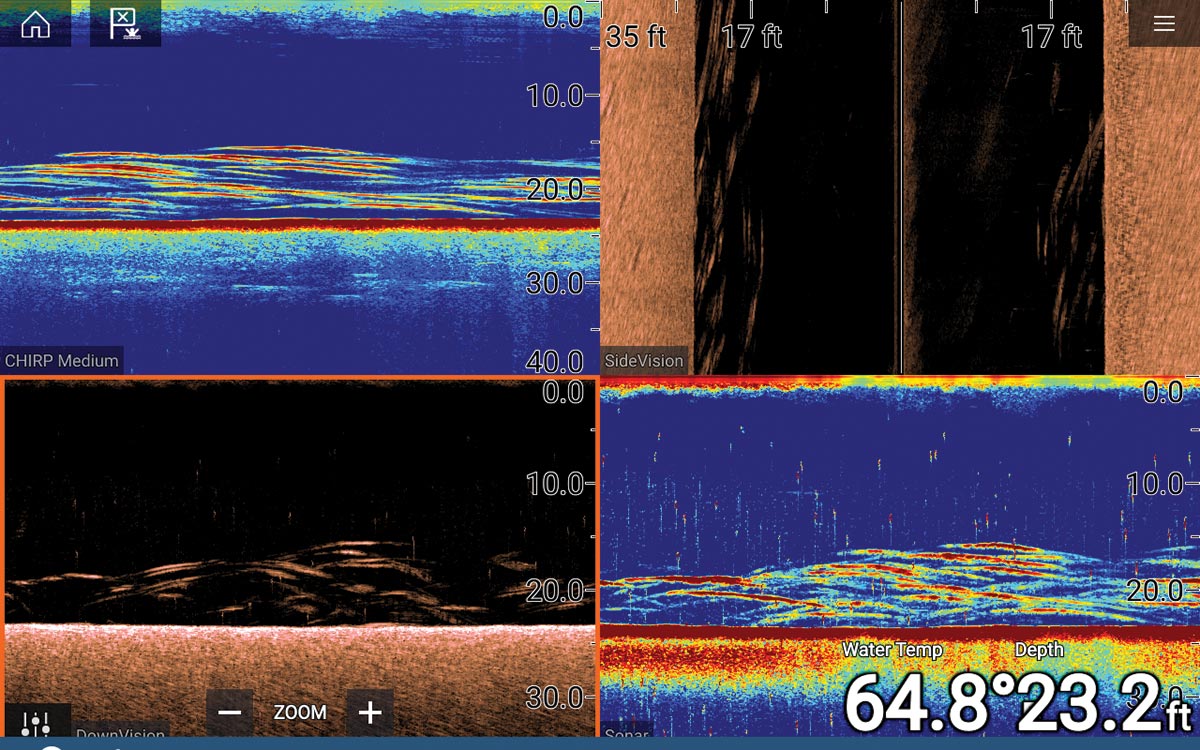
Given the number of weakfish along some parts of the coast this spring, and looking at some of the fishing that occurred in our region last season, I’m guardedly optimistic that we might be on the verge of a few good years of fishing here in the Northeast.
